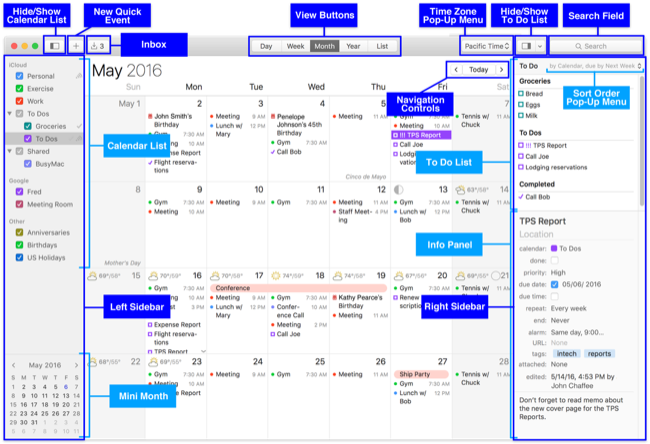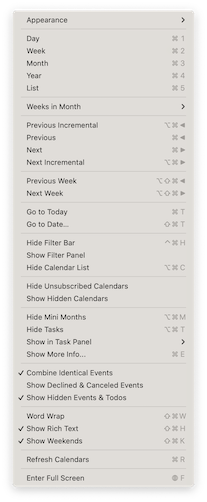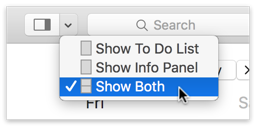The BusyCal Window
The main BusyCal window has a number of controls, some of which may not appear depending on your current settings.
NOTE: Some images in our online documentation may appear outdated as BusyCal continues to evolve over time. However, the core functionality mentioned in the documentation still applies.

The toolbar at the top of the window includes these controls:
- Do Not Disturb — Available in v3.9 and above. Temporarily silence and hide all alarms and sounds. All suppressed alarms will show once DND has turned off automatically, or manually by clicking the toggle button.
- Hide/Show Calendar List — Hide or display the left sidebar, which includes the Calendar List and one or more mini months. See Calendar List.
- New Quick Event — Create an event or task using natural language. See Quick Entry.
- Inbox — Displays notifications of meeting invitations and changes to shared calendars. See Receiving Meeting Invitations.
- View Buttons — Change the calendar’s current view. For details, see Day View, Week View, Month View, Year View, and List View.
- Time Zone Pop-up Menu — Change the time zone BusyCal is currently using. See Time Zones.
- Hide/Show Task List button — Hide or show the Task List, Info Panel, or the entire righthand sidebar. See Info Panel in Sidebar.
- Search Field — Type here to search for events or tasks, or to filter the calendar display. See Searching, Finding, and Filtering Events.
The left sidebar includes:
- Calendar List — A list of all the calendars in all accounts set up in BusyCal. See Calendar List.
- Mini Month — A miniature one-month calendar; drag the dividing line upward to see more months.
The main calendar pane includes:
- Navigation Controls — Click the left or right arrow to navigate forward or backward in time, or Today to jump to today.
The right sidebar includes:
- Sort Order pop-up menu — Change the way tasks are shown in the Task List.
- Task List — A customizable list of your tasks. See Task List.
- Info Panel — Editable details about the selected event or task. See Info Panel.
View Menu
NOTE: Depending on the version of BusyCal you're on, there may be several new options available (or some missing, in case you're on an older version).
The View menu contains controls for switching among calendar views, moving forward or backward in time, and adjusting the way various calendar views are displayed.

You can customize the calendar view by choosing any of following options from the View menu:
- Appearance — Switch between Automatic / Light or Dark mode.
- Days in Week — Sets the number of days to display in Week view. (This submenu appears only in Week view.)
- Weeks in Month — Sets the number of weeks to display in Month view. (This submenu appears only in Month view.)
- Show/Hide Filter Bar — Show or hide the Filter bar, where smart filter buttons are displayed.
- Show/Hide Calendar List Show or hide the Calendar List sidebar on the left.
- Show/Hide Unsubscribed Calendars — Show or hide unsubscribed calendars in the Calendar List sidebar on the left.
- Show/Hide Hidden Calendars — Show or hide hidden calendars in the Calendar List sidebar on the left. You can hide a calendar by right-clicking on the calendar and selecting "Hide".
Show/Hide Mini Months — Show or hide the mini month navigator on the bottom of the Calendar List sidebar on the left.
Tip: To display more mini months in the sidebar, drag the horizontal line above the mini month upward.
Show/Hide Task List — Show or hide the Task List sidebar on the right.
Show in Task List — Select what should appear in the Task List sidebar on the right when that sidebar is visible:
- Task List (⌘-Option-L) — The Task List
- Info Panel (⌘-Option-I) — The embedded Info Panel
- Both (⌘-Option-B) — The Task List at the top of the right sidebar, and the embedded Info Panel at the bottom. When both panels are visible, you can drag the horizontal divider line between them up or down to change their relative heights.
Combine Identical Events — Combine identical events found across different calendars and only the first appropriate event. When turned on, other identical events can be accessed via the Info Panel by selecting the visible event. BusyCal will pick the most appropriate event to display based on several heuristics, but most notably it will pick the one based on the Calendar sort order (in the left panel of the window).
Show Declined & Canceled Events — Show events that have been cancelled, or to which you’ve declined an invitation, on the calendar in strikethrough style.
Show Hidden Events — Show events that have been hidden (by previously right-clicking on selected events > Hide), on the calendar.
Word Wrap — Displays single or multi-line event titles in the Calendar view. Each display mode (Week, Month, List) can have separate word wrapping preferences. The Task list panel follows the currently applicable Word Wrap option.
Word Wrap Style - You can choose between wrap by word or wrap by character. The latter will better utilize the available space.
Show Rich Text — Displays plain or rich text event titles in the Calendar view.
Show Weekends — Show or hide weekends in Month/Week view. Does not apply to a Week view with custom number of days.
Sidebar Controls
BusyCal’s toolbar includes two controls that affect the visibility and behavior of the sidebars.
The Hide/Show Calendar List button, on the left, toggles display of the lefthand sidebar, which shows your Calendar List and, optionally, one or more mini month views at the bottom. (Clicking this button is the same as choosing View > Show/Hide Calendar List or pressing ⌘-Option-C.)

The Hide/Show Task List button, on the right, toggles display of the righthand sidebar, which shows your Task List, an embedded Info Panel, or both. (Clicking this button is the same as choosing View > Show/Hide Task List or pressing ⌘-Option-T.)
The pop-up menu on the right side of the Hide/Show Task List button lets you select whether the right sidebar shows the Task List, the embedded Info Panel, or both.

Go To Date
From the BusyCal View menu > Go To Date... you can quick jump to a particular date in the calendar. The Quick Search entry field allows you to enter free form text such as: 3 days, 3d (short for 3 days), 2 months (or 2m), friday, next week, next year, 2y and so on.
You can even enter fixed dates such as "3 jan 22" or "dec 2023". Entering a date in the Quick Search field allows you to quickly jump to a particular date on the date picker without having to click multiple times.